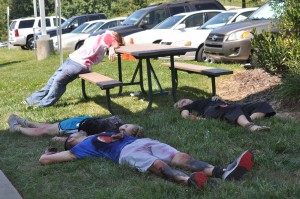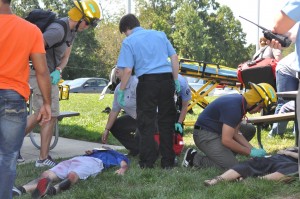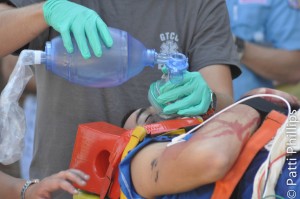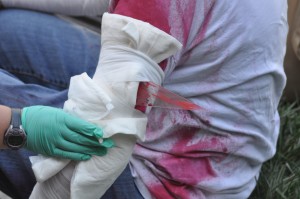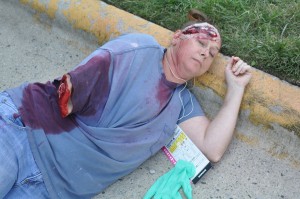(WARNING: Some photos may be disturbing to some viewers)
Not long ago, Sheila and I spent a pretty intense afternoon with a group of students and professionals doing a simulation of an explosion and its aftermath at a local campus. Here’s how it played out.
“You have reached 911. What’s the nature of your emergency?”
“A bomb just went off at the campus! There must be a dozen people hurt…there’s blood everywhere…”
Someone – a fellow student or perhaps a passing motorist – had called 911 and while sobbing or yelling the words into the phone, had begun the process to get help to the scene. The caller was kept on the phone in order to get any “who, what and where” details they might have known.
The 911 dispatcher made the appropriate call and told the First Responder, “There’s a possible explosion at the college. There may be multiple injuries.”
In general throughout the USA, the groups that respond will be from the Police/Sheriff, Fire, and Emergency Medical Services (EMS) Departments in the area. The unit that responds first is the First Responder and it is their responsibility to secure the scene. When the Law Enforcement agency arrives, they will determine if they are looking at a crime scene or whether something has accidentally exploded. In both cases, a perimeter is established.
If it is a crime scene, then access inside the perimeter will be limited to essential personnel and a sign in/out log will be used. An officer will guard the access point as long as is needed. This insures that evidence can be preserved as much as possible and that curious onlookers will not get in the way of either treatment of the victims or investigation of the scene.
Multiple victims, multiple injuries, an explosion and several agencies involved? How do they keep from tripping over each other? How do they know what to do next?
Each of the groups has a Command person in charge of that group. In addition, an Incident Commander is in charge of the entire scene, coordinating the efforts of everybody concerned.
Victims are prioritized by type of wound, and then tagged with a card that identifies the level of injury, before they are eligible for transport. In general, the tag colors indicate:
*Black tags – not breathing
*Red tags – will die if not treated immediately, but still breathing on own
*Yellow tags – broken bones, but alert
The ones having sustained the most serious injuries and who have the greatest likelihood of survival, are treated and transported first by EMS Transport Command.
Other victims who have superficial cuts and abrasions are treated at the scene and released from care.
One of the simulation victims had a piece of glass ‘stuck’ in her arm as a result of being too close to windows that shattered during the explosion. The EMS gal treating her explained that the glass would keep the wound from bleeding until the victim reached the hospital. Basically, it was plugging the hole in her arm. If the police considered the glass a piece of evidence, it would be collected, bagged and tagged at the hospital. The piece of glass would only be removed at the scene if the patient could not breathe or if it got in the way of doing CPR. Since the glass was in her arm, it was left there and bandages were wrapped around it.
The Incident Commander explained that the first priority was the treatment of the patients and that all evidence on (or in) the victims would be collected later at the hospital. The EMS does not remove anything from the scene if they can help it.
The police began to take statements from the witnesses after treatment was in progress, but prioritized the questioning – least hurt, most alert, were questioned first. The EMS people are under HIIPA rules, so are not allowed to share any information they see or gather from the victims being treated. The police have to get that info on their own. At some point, the law enforcement officers would obtain an order for medical records of the person who caused the explosion.
Sadly, one of the victims ‘died’ during the simulation, as would happen in real life. This lady did not make it because her injuries were so severe. (only a simulation – that’s a great makeup job)
If all this were really happening, area airports and highways would be shut down until the threat level was determined. Was it an accident in a lab? Or was it a terrorist action? Unless the investigators get lucky and somebody confesses or does the ‘big reveal’ right at the scene, the truth is, that at an hour after the initial explosion, all that is known for sure is that lots of people have been hurt.
Sheila and I were impressed with how well the simulation went and how well organized it was. Great experience for us to see how a well-trained group can bring sanity to a potentially chaotic situation.
*Photos taken by Patti Phillips at a real simulation conducted in Guilford County, NC at the Writers’ Police Academy.
*Sheila and Charlie Kerrian are fictional characters, but the simulation actually took place.

